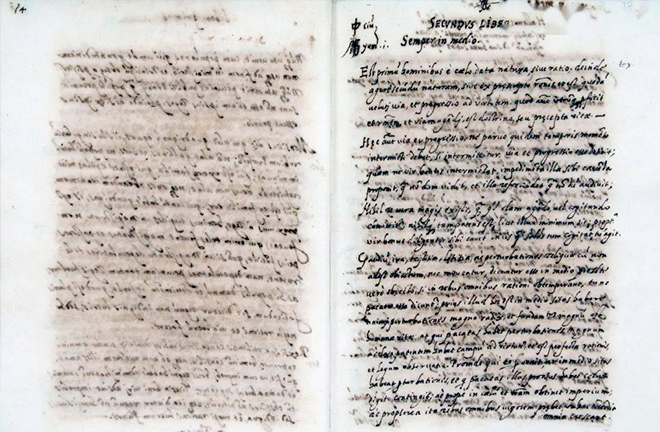International affinity for Chinese culture and translation strategies

FILE PHOTO: Manuscript of the Latin-language version text of The Doctrine of the Mean, translated by the Italian missionary Michele Ruggleri
Affinity denotes the feeling of closeness and warmth towards a person or thing. By interviewing more than 300 foreigners through different social networks, and other forms of social interaction, we tried to understand their familiarity with Chinese culture and their inclinations.
The interviewees come from 41 countries, including the US, Britain, France, Germany, Canada, Australia, and Japan, and their professions include diplomats, Sinologists, writers, lawyers, engineers, workers, cooks, tour guides, CEOs, managers, and other businessmen. The interviewees were between 20 and 50 years old, and among the survey sample, foreign students and foreign teachers accounted for a large proportion.
In addition, we also collected research results from academic circles, The opinions of international academia were mostly gathered from foreign literature aggregated from the Web of Science and in books published by Springer, and Chinese literature was collected from China National Knowledge Infrastructure (CNKI) and Chinese texts. According to interviews, the international community’s affinity for Chinese culture, based on the degree of fondness, is Chinese cuisine, Chinese martial art films, Chinese traditional medicine, and Chinese classics (in order of priority.)
Chinese cuisine is the epitome of Chinese wisdom and traditional Chinese culture, and has gradually become a window for the world to understand China. Widely known in many countries and regions with a good reputation, it has taken root overseas with many dishes which combine exotic elements. Chinese entrepreneurs who opened restaurants overseas in an earlier time, established a basic translation style for the names of Chinese dishes—that is to translate according to their pronunciations in Chinese dialects. The English name “Lao Gan Ma Chili Crisp Sauce,” a Chinese food product, is also a result of translation by Chinese pronunciation. With many fans on Twitter and a homepage in Facebook, it has become popular overseas.
Chinese martial art film ranks second in terms of its international affinity. More than 90% of interviewees are familiar with it, but they appreciate martial art films only by watching the physical motions and imagery, while the content of films is secondary. Many interviewees said that they do not read the film’s subtitles, and some viewers who read the film subtitles felt dissatisfied with the translation. When we analyze specific cases, we find that this phenomenon is not caused by translation itself, but by cultural differences. For example, the translation of official titles in ancient China can cause great confusion to foreign readers.
The third cultural touchstone is Traditional Chinese Medicine (TCM), which has shifted from being relatively unknown to gradually accepted. We also conducted interviews with students majoring in TCM in the US, and learned that American medical students studying TCM are not accustomed to current translations, and the cultural attributes and distinctive features of TCM hinder their understanding. In fact, the translations they need are more comprehensive than an ordinary translation. Translation is cross-cultural, and the concept of TCM differs greatly from that of Western medicine. For example, when discussing human organs or functions, TCM textbooks often involve the circulatory system of the whole body as an entirety, but this is not part of the human organ teaching system in American medicine. Medical students in the US thus need translators to provide background knowledge in this area, but the translation of TCM knowledge is less likely to take this into account.
Fourth in this survey are the Chinese classics, which were mainly translated by Westerners centuries ago. Since the Italian Jesuit priest and missionary Michele Ruggleri translated parts of The Great Learning and Mencius into Latin in 1581, the “Four Books and Five Classics,” which represent the mainstream traditional Chinese culture, have been translated into more than 300 versions. During the the 17th and 18th centuries when Chinese culture spread like wildfire in the West, it was fashionable to learn to quote sayings from The Analects of Confucius. Even when China was relatively weak in the 19th century, the appeal of Confucianism could still be seen in such European and American famous intellectuals as Goethe, Pushkin, and Tolstoy. At present, although ordinary people overseas have little contact with translations of Confucian classics, overseas translators and scholars are still actively engaged in the study of these classics.
Other cultural elements of Chinese daily life that are also favored by foreigners include tea, ceramics, clothing, and so forth, which will not be detailed here. In order to continuously improve the international affinity for Chinese culture, it is necessary not only to emphasize the dissemination of Chinese culture, but also emphasize the strategies. For example, with regard to the spread of TCM, when more people realize that there are many health problems that can be solved by TCM, or that some health problems are better treated by TCM, its popularity will naturally increase. These efforts should be assisted by translation, and vice versa, translation strategies should also be adapted to the context of the international community.
Yue Feng and Lu Xuemei are from the College of Foreign Languages at the Fujian Normal University.
Edited by BAI LE
